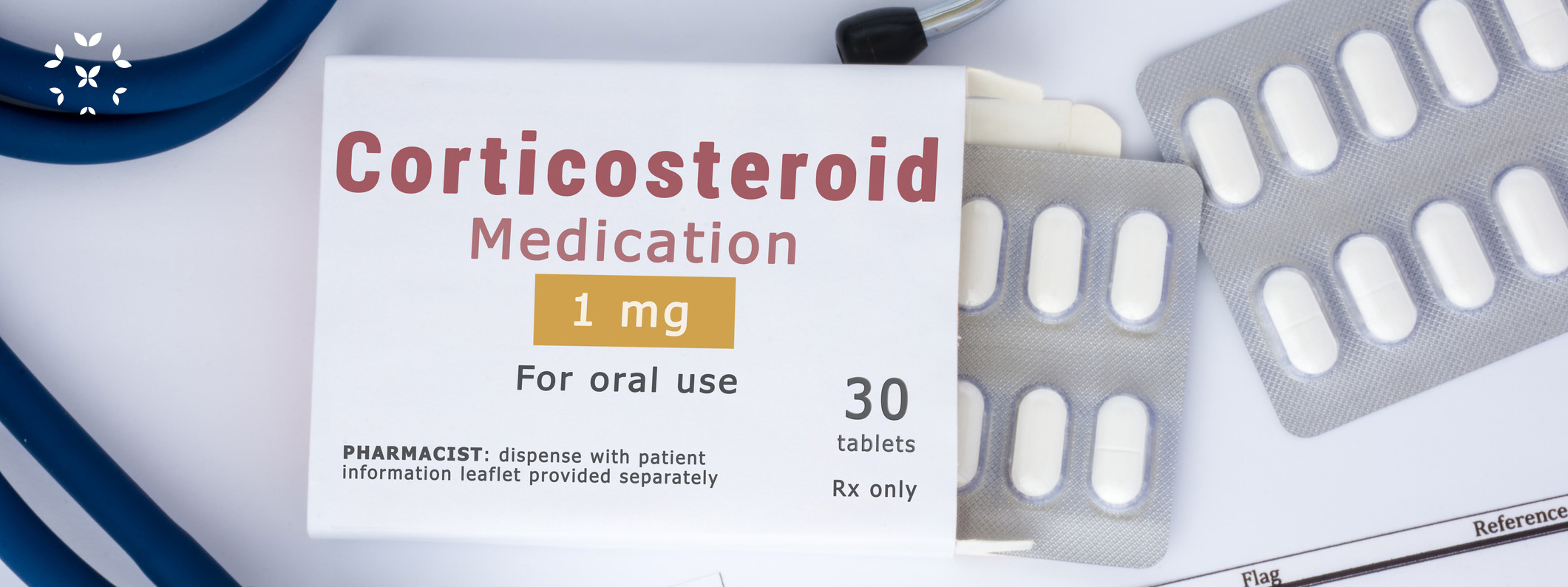Lupus and Tapering Steroids
Corticosteroids, like prednisone, can be life-changing – even life-saving – for those living with lupus. Yet, they carry serious side-effects and can disrupt your quality of life. So, how to balance the good with the bad? Under physician supervision, carefully tapering your steroid dosages –even eliminating them – may be the answer. Read on to find out how!
- Lupus and Steroids: The 1-minute Overview
- What are steroids and how do they work?
- What is the latest on tapering steroids for lupus patients?
- Dr. Sharon Dowell on Tapering Steroids (Educational Video)
- In Conclusion: What could this mean for you?
Note: This article is for information purposes only and is not meant to replace advice from your physician. Always, check with your healthcare provider before making any changes to your medications.
Lupus and Steroids: The 1-minute Overview
Corticosteroids are a powerful class of drugs that attack one of the most damaging aspects of lupus – inflammation. Most are also immunosuppressive, meaning they can slow down the immune system, and that makes them even better for autoimmune conditions like SLE.
By far, the most commonly prescribed corticosteroid for lupus patients is prednisone, and if you have SLE, you probably already have a love/hate relationship with this powerful drug. Why the love/hate?
On the positive side, prednisone (and most steroids) are effective because:
- They work and they work quickly, often providing noticeable improvement within an hour of taking them.
- They improve inflammation systemically, reaching all parts of the body.
- They can give you an energy boost – at least for a while.
- Importantly, they are readily available and covered by most insurance policies.
Unfortunately, corticosteroids also have profound side effects. The downside of steroids include these facts:
- They can increase your appetite, which can lead to weight gain and all that comes with it.
- They can cause puffiness and swelling in the face and extremities.
- They cause high blood pressure and high blood glucose levels.
- Steroids can also affect your emotional health causing depression, anxiety and brain fog.
- If taken long-term, the side effects may affect your eye with cataracts and glaucoma.
- They also can lead to other conditions like Cushing’s syndrome, type 2 diabetes, osteoporosis and a host of other problems.
For many years, these side effects were assumed to be unavoidable – a necessary trade off or the “price of admission” in the fight against the even more damaging and life-threatening effects of lupus. However, rheumatologists are now finding that many patients can safely reduce their use of steroids more than was thought possible in the past.
Additionally, there is growing evidence that even low maintenance levels of prednisone – 5 mg per day – are not always necessary for maintaining low disease activity. This has led to the possibility that the tapering, and perhaps completely withdrawing of corticosteroids, may be a reasonable and achievable goal for some living with lupus!
.
What are steroids and how do they work?
“Steroids” is the shortened term for corticosteroids or glucocorticoids (a subclass of corticosteroids) that include hormones naturally produced by the cortex of the adrenal glands. The most significant of these is cortisol, which plays many roles in the body. Sometimes called the “stress hormone,” cortisol affects the body’s metabolism, especially blood sugar, and it weakens the immune system. This is one reason why stress might leave a person open for other illnesses.
Corticosteroid medications mimic the effects of natural hormones like cortisol. The most commonly prescribed steroids include:
- Cortisone, often injected to relieve local pain and inflammation;
- Prednisone, the most commonly prescribed for SLE, and taken in tablet form;
- Prednisolone, given to autoimmune patients with severe liver disease;
- Hydrocortisone, often used in topical creams for skin pain and itch;
- Triamcinolone, a very potent steroid given as an intra-muscular injection, and
- Methylprednisolone – used as a “pulse steroid” infusion for lupus patients who need a strong, but short-term dose.
As anti-inflammatories, corticosteroids are among the most commonly prescribed medications for a wide range of conditions, including some that can be comorbidities with lupus, such as vasculitis, rheumatoid arthritis, asthma and some allergies, contact dermatitis, Crohn’s disease, ulcerative colitis and many others.
How do corticosteroids work?
Steroids are both anti-inflammatory and immunosuppressive:
- They can reduce the production of the chemicals that cause damaging inflammation, such as cytokines, and inflammatory enzymes. They do this by entering the cells of the body and blocking the very genes that produce these harmful chemicals.
- They also reduce the ability of certain white blood cells to activate and ramp up the autoimmune response. It has been found that steroids affect the ability of overactive white blood cells to enter and move through tissues – shielding organs from their damaging effects.
These are compelling reasons to take steroids. However, because they are so powerful and have such significant side effects, most steroids were not developed to be the long-term medication that they have become for so many people with chronic inflammatory diseases.
Another issue is the fact that when a person takes steroids for a long enough period of time, the body’s own adrenal cortex stops making cortisol and other corticosteroids naturally. So, if a person’s lupus is either in remission or at a very low disease state, it is important to reduce steroid use as much as possible to re-train the body to produce its own again.
This has to be done slowly and carefully! The trick is to gradually taper the steroids in a way that does not trigger a lupus flare and a return to organ damaging inflammation. How? Recent clinical studies have begun to provide some answers.
 .
.
What is the latest on tapering steroids for lupus patients?
There are many opinions as to how best to reduce or taper steroids. Please note, this area of research and the subsequent clinical recommendations can change rapidly. As always, check with your healthcare provider first, and only make changes under their supervision!
As mentioned, any reduction in the dosage of most corticosteroids needs to be very slow, gradual and carefully monitored. Abruptly stopping steroids can be dangerous. Also, the longer you have taken steroids (long-term usually meaning more than one year), the more gradual the tapering needs to be. That being said …
In 1998, a study recommended that patients taking prednisone at high doses (50+ mg per day) or moderate dosages (10 – 25 mg per day) could safely taper to the low or “maintenance” dosage of 5 mg per day if tapered over the course of a few months. In recent years, this has been a standard goal for many with lupus who have achieved either low disease activity or even clinical remission.
In 2019, a small study found that for patients who had achieved long-term, clinical remission of their lupus, the vast majority (84.6%) were able to taper and successfully end taking glucocorticoids all together. Of these, 54% achieved complete remission, though 23% experienced a flare, on average, in the first year.
In 2021, the University of Toronto Lupus Clinic, studied patients who had been in remission for at least two years. They found that those who tapered and discontinued prednisone actually had fewer and less severe flares, than patients who maintained dosages of 5 mg per day over the same time period. The University of Toronto Lupus Clinic recommended a gradual decrease of prednisone dosage over several months. Once a patient achieved a “maintenance” dosage of 5 mg per day, the final tapering could begin using a 9 to 18 month, supervised schedule.
A few similar studies replicated these findings. However, in 2022, a large study presented at the American College of Rheumatology Convergence found that, for those not in complete remission, tapering of corticosteroids and immunosuppressive therapies showed an increase in lupus flares. This was a warning that tapering may not always work.
Though tapering works for some, it does not work for all. These studies also highlight the need to continue taking that other medications, like hydroxychloroquine, in order to avoid flares and other complications.
The good news is that several new medications that specifically target the inflammatory response associated with systemic lupus erythematosus, such as Saphnelo (anifrolumab), may make it possible to further reduce the need for corticosteroids and allow for tapering to happen more quickly, more completely and for more patients.
It is important to remember that everyone experiences lupus differently and everyone experiences the effects of prednisone differently. Still, there is a growing body of research that gives hope for many that gradually tapering and perhaps even eliminating the use of steroids is not only possible, but an achievable goal.
Dr. Sharon Dowell on Tapering Steroids (Educational Video)
.
In Conclusion: What could this mean for you?
If you are taking corticosteroids, like prednisone, you probably are living the love/hate relationship with them. For all of the promising news that steroid tapering studies have shown, only you and your healthcare provider can balance the benefits and side effects of these powerful medications. However, there is great hope – and clinical evidence – that maintaining a healthy lifestyle, sticking to treatment plans, avoiding lupus flare triggers, and the possibilities of using new, more targeted lupus medications will make the process of tapering steroids a real possibility.
.
References
Arthritis Foundation (2023). Corticosteroids. https://www.arthritis.org/drug-guide/corticosteroids/corticosteroids
Buttgareit, F., & Palmowski, A. (2022). How to taper glucocorticoids in inflammatory rheumatic diseases? A narrative review of novel evidence in rheumatoid arthritis, systemic lupus erythematosus, and giant cell arteritis. Joint Bone Spine,89(1). Article 105285. https://doi.org/10.1016/j.jbspin.2021.105285
Johns Hopkins Lupus Center (2023). Treating lupus with steroids. https://www.hopkinslupus.org/lupus-treatment/lupus-medications/steroids/
Lopez, M.A. (2022). Corticosteroids or immunosuppressive therapy tapering increases flares in stable SLE. American College of Rheumatology. Retrieved from https://www.rheumatologyadvisor.com/reports/corticosteroids-or-immunosuppressive-therapy-tapering-increases-flares-in-stable-sle/
Porta, S., Danza, A., Arias Saavedra, M., Carlomagno, A., Goizueta, M. C., Vivero, F., & Ruiz-Irastorza, G. (2020). Glucocorticoids in systemic lupus erythematosus. Ten questions and some issues. Journal of Clinical Medicine, 9(9), Article 2709. https://doi.org/10.3390/jcm9092709
Ruiz-Irastorza, G. (2021). Prednisone in systemic lupus erythematosus: taper quickly, withdraw slowly. Rheumatology, 60(12), 5489–5490, https://doi.org/10.1093/rheumatology/keab347
Tselios, K., Gladman, D.D., Al-Sheikh, H., Su, J. and Urowitz, M.B. (2022), Medium versus high initial prednisone dose for remission Iinduction in Llupus nephritis: A propensity score–matched analysis. Arthritis Care Research, (74),1451-1458. https://doi.org/10.1002/acr.24592
Tselios, K., Gladman, D.D., Su, J. & Urowitz, M.B. (2021). Gradual glucocorticosteroid withdrawal Is safe in clinically quiescent systemic lupus erythematosus. ACR Open Rheumatology, (3), 550-557. https://doi.org/10.1002/acr2.11267
.
Author: Greg Dardis, MS
Professor Dardis was formerly the Chair of the Science Department at Marylhurst University and is currently an Assistant Professor at Portland State University. His focus has been human biology and physiology with an interest in autoimmunity. Professor Dardis is also the President of the Board of Directors of Kaleidoscope Fighting Lupus.
All images unless otherwise noted are property of and were created by Kaleidoscope Fighting Lupus. To use one of these images, please contact us at [email protected] for written permission; image credit and link-back must be given to Kaleidoscope Fighting Lupus.
All resources provided by us are for informational purposes only and should be used as a guide or for supplemental information, not to replace the advice of a medical professional. The personal views expressed here do not necessarily encompass the views of the organization, but the information has been vetted as a relevant resource. We encourage you to be your strongest advocate and always contact your healthcare practitioner with any specific questions or concerns.

